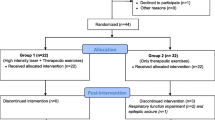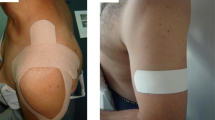Abstract
Purpose
Patients who are post-implantation of cardiac rhythm management devices (CRMDs) are commonly instructed to restrict ipsilateral arm movement to reduce risk of lead dislodgement. This immobilization practice increases risk of shoulder-related pain leading to limited shoulder function. We aimed to assess effect of pendulum exercise on shoulder function in patients after CRMD implantation.
Methods
This study was a prospective, randomized, open-blinded end point study conducted with 200 patients undergoing CRMD implantation. They were randomized into two groups, standard care (control) and pendulum exercise (experimental) groups. The shoulder function was assessed using QuickDASH-TH scores and measurement of the range of motion (ROM) of shoulder abduction and flexion before and 1 month after implantation.
Results
Baseline characteristics did not differ between the two groups. The lower incidence of shoulder ROM reduction after CRMD implantation was demonstrated in the pendulum exercise group compared to the control group in both flexion (16.8% vs. 40.4%, P < 0.001) and abduction (9.9% vs. 32.3%, P < 0.001). A lower disability of shoulder function after implantation assessed by QuickDASH-TH scores was also noted in the exercise group compared to control (15.2 ± 16.4 vs. 23.4 ± 18.1, P = 0.001). Two patients in the control group and one in the exercise group had atrial lead dislodgement on the day following the procedure.
Conclusions
Early pendulum exercise with ipsilateral arm after CRMD implantation was safe and resulted in lower incidence of limited shoulder ROM and less disability of shoulder function compared to control group.
Trial registration
The study was registered in clinicaltrials.in.th, and the identification number is TCTR20180612003.

Similar content being viewed by others
References
Diemberger I, Pegreffi F, Mazzotti A, Foschi E, Martignani C, Belli G, et al. Implantation of cardioverter-defibrillator: effects on shoulder function. Int J Cardiol. 2013;168(1):294–9. https://doi.org/10.1016/j.ijcard.2012.09.071.
Jones GK, Bardy GH, Kudenchuk PJ, Poole JE, Dolack GL, Troutman C, et al. Mechanical complications after implantation of multiple-lead nonthoracotomy defibrillator systems: implications for management and future system design. Am Heart J. 1995;130(2):327–33.
Adams J, Cline MJ, Hubbard M, McCullough T, Hartman J. A new paradigm for post-cardiac event resistance exercise guidelines. Am J Cardiol. 2006;97(2):281–6. https://doi.org/10.1016/j.amjcard.2005.08.035.
Korte T, Niehaus M, Meyer O, Tebbenjohanns J. Prospective evaluation of catheter ablation in patients with implantable cardioverter defibrillators and multiple inappropriate ICD therapies due to atrial fibrillation and type I atrial flutter. Pacing Clin Electrophysiol. 2001;24(7):1061–6.
Daniels JD, Sun S, Zafereo J, Minhajuddin A, Nguyen C, Obel O, et al. Preventing shoulder pain after cardiac rhythm management device implantation: a randomized, controlled study. Pacing Clin Electrophysiol. 2011;34(6):672–8. https://doi.org/10.1111/j.1540-8159.2010.03026.x.
Tongprasert S, Rapipong J, Buntragulpoontawee M. The cross-cultural adaptation of the DASH questionnaire in Thai (DASH-TH). J Hand Ther. 2014;27(1):49–54. https://doi.org/10.1016/j.jht.2013.08.020.
LeBlanc M, Stineman M, DeMichele A, Stricker C, Mao JJ. Validation of QuickDASH outcome measure in breast cancer survivors for upper extremity disability. Arch Phys Med Rehabil. 2014;95(3):493–8. https://doi.org/10.1016/j.apmr.2013.09.016.
Oosterwijk AM, Nieuwenhuis MK, van der Schans CP, Mouton LJ. Shoulder and elbow range of motion for the performance of activities of daily living: a systematic review. Physiother Theory Pract. 2018;34(7):505–28. https://doi.org/10.1080/09593985.2017.1422206.
Naffe A, Iype M, Easo M, McLeroy SD, Pinaga K, Vish N, et al. Appropriateness of sling immobilization to prevent lead displacement after pacemaker/implantable cardioverter-defibrillator implantation. Proceedings. 2009;22(1):3–6.
Acknowledgments
We would like to thank all staff in the Northern Cardiac Center and Division of Cardiology, Department of Internal Medicine, Faculty of Medicine, Chiang Mai University, for their cooperation in the study.
Author information
Authors and Affiliations
Corresponding author
Ethics declarations
Conflict of interest
The authors declare that they have no conflict of interest.
Funding
This work was supported by grants from the Thailand Research Fund (MRG RSA5780039 (W.W), MRG RSA5780040 (A.P.)), and the Faculty of Medicine Endowment Fund for Medical Research (082/2560), Chiang Mai University, Thailand.
Ethical approval
All procedures performed in studies involving human participants were in accordance with the ethical standards of the Institutional Research Board of the Faculty of Medicine, Chiang Mai University (approval number 321/2559) and with 1964 Helsinki Declaration and its later amendments or comparable ethical standards.
Informed consent
Informed consent was obtained from all individual participants included in the clinical study.
Additional information
Publisher’s note
Springer Nature remains neutral with regard to jurisdictional claims in published maps and institutional affiliations.
Rights and permissions
About this article
Cite this article
Wongcharoen, W., Petvipusit, W., Prasertwitayakij, N. et al. Effect of early pendulum exercise on shoulder function after cardiac rhythm management device implantation. J Interv Card Electrophysiol 55, 343–347 (2019). https://doi.org/10.1007/s10840-019-00541-y
Received:
Accepted:
Published:
Issue Date:
DOI: https://doi.org/10.1007/s10840-019-00541-y




